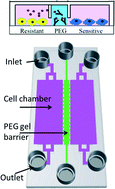Microfluidic co-cultures with hydrogel-based ligand trap to study paracrine signals giving rise to cancer drug resistance†
Abstract
Targeted cancer therapies are designed to deactivate signaling pathways used by cancer cells for survival. However, cancer cells are often able to adapt by activating alternative survival pathways, thereby acquiring drug resistance. An emerging theory is that autocrine or paracrine growth factor signaling in the cancer microenvironment represent an important mechanism of drug resistance. In the present study we wanted to examine whether paracrine interactions between groups of melanoma cells result in resistance to vemurafenib – an FDA approved drug targeting the BRAF mutation in metastatic melanoma. We used a vemurafenib-resistant melanoma model which secretes fibroblast growth factor (FGF)-2 to test our hypothesis that this is a key paracrine mediator of resistance to vemurafenib. Sensitive cells treated with media conditioned by resistant cells did not protect from the effects of vemurafenib. To query paracrine interactions further we fabricated a microfluidic co-culture device with two parallel compartments, separated by a 100 μm wide hydrogel barrier. The gel barrier prevented resorting/contact of cells while permitting paracrine cross-talk. In this microfluidic system, sensitive cells did become refractive to the effects of vemurafenib when cultured adjacent to resistant cells. Importantly, incorporation of FGF-2 capture probes into the gel barrier separating the two cell types prevented onset of resistance to vemurafenib. Microfluidic tools described here allow for more sensitive analysis of paracrine signals, may help better understand signaling in the cancer microenvironment and may enable development of more effective cancer therapies.

- This article is part of the themed collection: Nanoengineering for Medicine and Biology (NEMB 2015)

 Please wait while we load your content...
Please wait while we load your content...